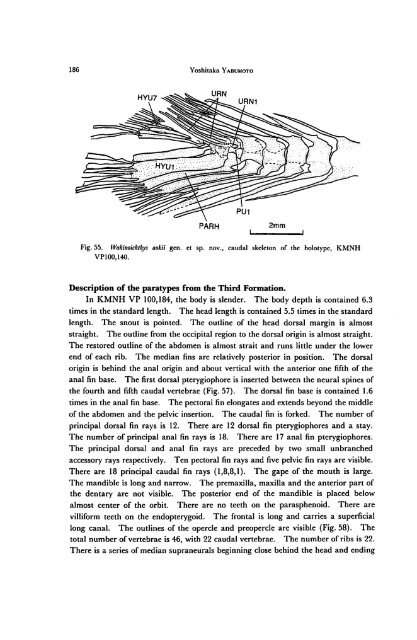Early Cretaceous Freshwater Fish Fauna in Kyushu, Japan
Early Cretaceous Freshwater Fish Fauna in Kyushu, Japan
Early Cretaceous Freshwater Fish Fauna in Kyushu, Japan
You also want an ePaper? Increase the reach of your titles
YUMPU automatically turns print PDFs into web optimized ePapers that Google loves.
186 Yoshitaka Yabumoto<br />
URN<br />
URN1<br />
PU1<br />
PARH<br />
2mm<br />
Fig. 55. Wak<strong>in</strong>oichthys aokii gen. et sp. nov., caudal skeleton of the holotype, KMNH<br />
VP100,140.<br />
Description of the paratypes from the Third Formation.<br />
In KMNH VP 100,184, the body is slender. The body depth is conta<strong>in</strong>ed 6.3<br />
times <strong>in</strong> the standard length. The head length is conta<strong>in</strong>ed 5.5 times <strong>in</strong> the standard<br />
length. The snout is po<strong>in</strong>ted. The outl<strong>in</strong>e of the head dorsal marg<strong>in</strong> is almost<br />
straight. The outl<strong>in</strong>e from the occipital region to the dorsal orig<strong>in</strong> is almost straight.<br />
The restored outl<strong>in</strong>e of the abdomen is almost strait and runs little under the lower<br />
end of each rib. The median f<strong>in</strong>s are relatively posterior <strong>in</strong> position. The dorsal<br />
orig<strong>in</strong> is beh<strong>in</strong>d the anal orig<strong>in</strong> and about vertical with the anterior one fifth of the<br />
anal f<strong>in</strong> base. The first dorsal pterygiophore is <strong>in</strong>serted between the neural sp<strong>in</strong>es of<br />
the fourth and fifth caudal vertebrae (Fig. 57). The dorsal f<strong>in</strong> base is conta<strong>in</strong>ed 1.6<br />
times <strong>in</strong> the anal f<strong>in</strong> base. The pectoral f<strong>in</strong> elongates and extends beyond the middle<br />
of the abdomen and the pelvic <strong>in</strong>sertion. The caudal f<strong>in</strong> is forked. The number of<br />
pr<strong>in</strong>cipal dorsal f<strong>in</strong> rays is 12. There are 12 dorsal f<strong>in</strong> pterygiophores and a stay.<br />
The number of pr<strong>in</strong>cipal anal f<strong>in</strong> rays is 18. There are 17 anal f<strong>in</strong> pterygiophores.<br />
The pr<strong>in</strong>cipal dorsal and anal f<strong>in</strong> rays are preceded by two small unbranched<br />
accessory rays respectively. Ten pectoral f<strong>in</strong> rays and five pelvic f<strong>in</strong> rays are visible.<br />
There are 18 pr<strong>in</strong>cipal caudal f<strong>in</strong> rays (1,8,8,1). The gape of the mouth is large.<br />
The mandible is long and narrow. The premaxilla, maxilla and the anterior part of<br />
the dentary are not visible. The posterior end of the mandible is placed below<br />
almost center of the orbit. There are no teeth on the parasphenoid. There are<br />
villiform teeth on the endopterygoid. The frontal is long and carries a superficial<br />
long canal. The outl<strong>in</strong>es of the opercle and preopercle are visible (Fig. 58). The<br />
total number ofvertebrae is 46, with 22 caudal vertebrae. The number of ribs is 22.<br />
There is a series of median supraneurals beg<strong>in</strong>n<strong>in</strong>g close beh<strong>in</strong>d the head and end<strong>in</strong>g

















